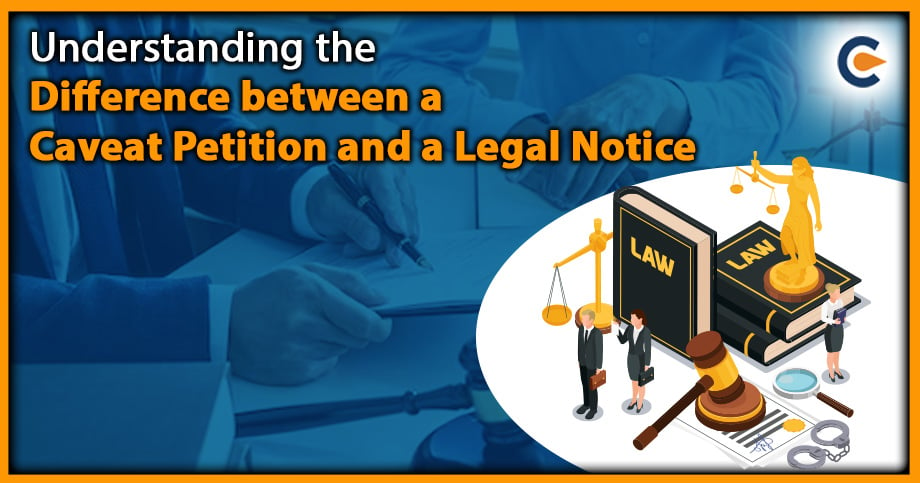Legal proceedings can be complicated and confusing for individuals who are not well-versed in the law. In particular, two terms that are often used in legal matters are Caveat Petition and Legal Notice. These two legal instruments are commonly used in India to prevent or resolve disputes. This blog will explain the difference between a Caveat Petition and a Legal Notice.
What is a Caveat Petition?
Section 148 A states the following: When an application is anticipated to be made or has been made in a suit or proceeding in a court, any person who claims to have the right to appear in court on the hearing of the respective application may lodge a caveat. A Caveat Petition is a legal instrument that is filed in court to request that the court not take any action without notifying the person who filed the petition. This petition is filed when there is a possibility of a legal dispute arising in the future. A caveat petition is filed to prevent an ex parte order, which is an order passed by a court without giving the other party an opportunity to be heard. In simpler terms, a caveat petition is a warning to the court to give notice to the person who filed the petition before taking any action in a particular case.
What is a Legal Notice?
A legal notice is filed as per Section 80 of the Code of Civil Procedure, 1908[1], and is only filed in civil cases. A legal document is intimation and thus carries the following information: Precise statements and facts relating to the grievance for which the action is to be taken A Legal Notice is a formal communication sent by one party to another party informing them of their intention to take legal action against them. A legal notice is sent when one party believes that their legal rights have been violated by another party. The legal notice informs the other party of the intention to take legal action if the dispute is not resolved amicably.
Difference between Caveat Petition and Legal Notice
- Purpose:
The purpose of a Caveat Petition is to prevent an ex parte order by the court. On the other hand, the purpose of a Legal Notice is to inform the other party of the intention to take legal action against them.
- Stage Of Legal Proceedings:
A Caveat Petition is filed before any legal proceedings have begun, whereas a Legal Notice is sent after a dispute has arisen and legal action is being considered.
- Jurisdiction:
A Caveat Petition can be filed in any court having jurisdiction over the matter. However, a Legal Notice can only be sent to a party who is within the jurisdiction of the court where legal proceedings will be initiated.
- Notice:
In the case of a Caveat Petition, the person who filed the petition is notified by the court before any ex parte order is passed. In contrast, a Legal Notice is sent by one party to another party informing them of their intention to take legal action.
- Nature of the Petition:
A Caveat Petition is a defensive measure, which means it is filed by a party to defend against any potential legal action that may be taken against them in the future. On the other hand, a Legal Notice is an offensive measure, which means it is sent by a party to inform the other party of their intention to take legal action against them.
- Scope of the Petition/Notice:
A Caveat Petition is limited in its scope and can only be used to prevent ex parte orders. A Legal Notice, on the other hand, can cover a wide range of legal issues, including breach of contract, infringement of intellectual property rights, defamation, etc.
- Effect On Legal Proceedings:
The filing of a Caveat Petition does not guarantee that the party who filed it will win the case. It simply ensures that they will be notified before any ex parte order is passed. A Legal Notice, on the other hand, is often the first step in initiating legal proceedings and can sometimes lead to a settlement between the parties without going to court.
- Time Limit:
A Caveat Petition remains in force for a limited period of time, typically six months, and can be renewed if necessary. A Legal Notice does not have a specific time limit, but legal action must be initiated within a reasonable amount of time after the notice has been served.
Conclusion
In conclusion, a caveat petition and a legal notice are two different legal instruments used in India to prevent or resolve disputes. While a caveat petition is filed to prevent ex parte orders by the court, a legal notice is sent to inform the other party of the intention to take legal action against them. These two instruments differ in their purpose, stage of legal proceedings, jurisdiction, notice, nature, scope, effect on legal proceedings, and time limit. It is important to understand the differences between them and consult with a lawyer before deciding which one to use in a particular situation.
Also Read:
How To File A Caveat Petition In India?











